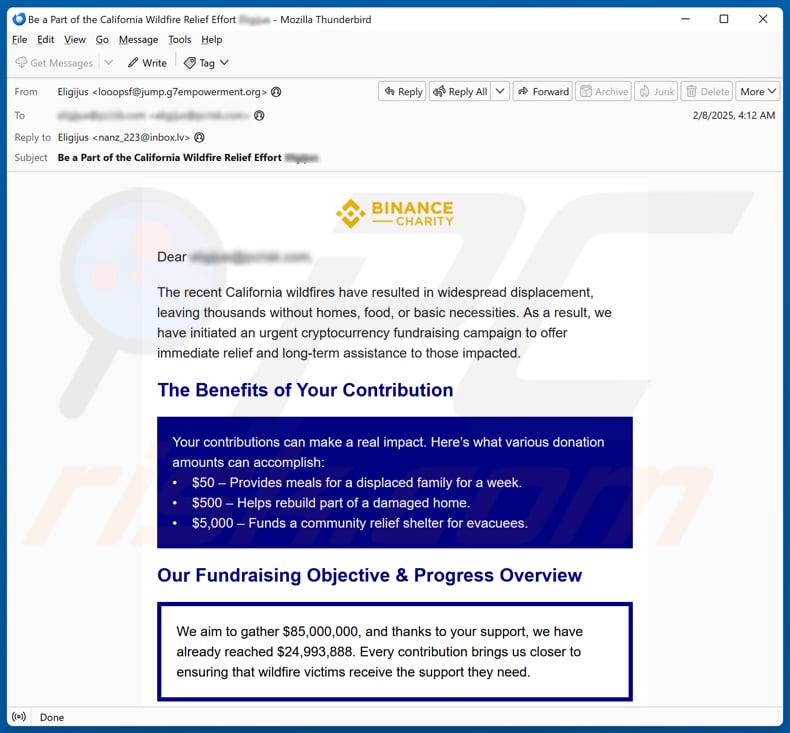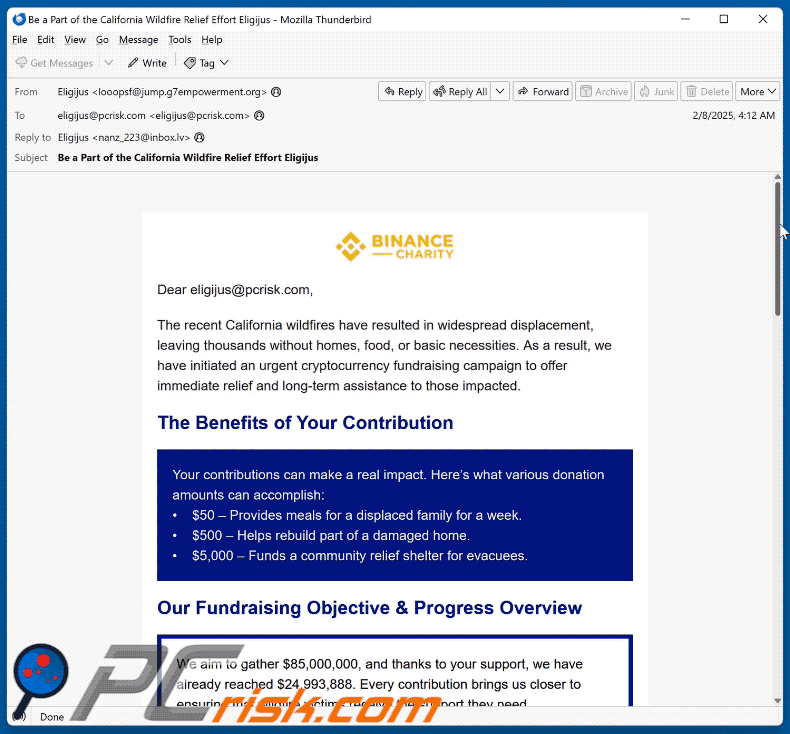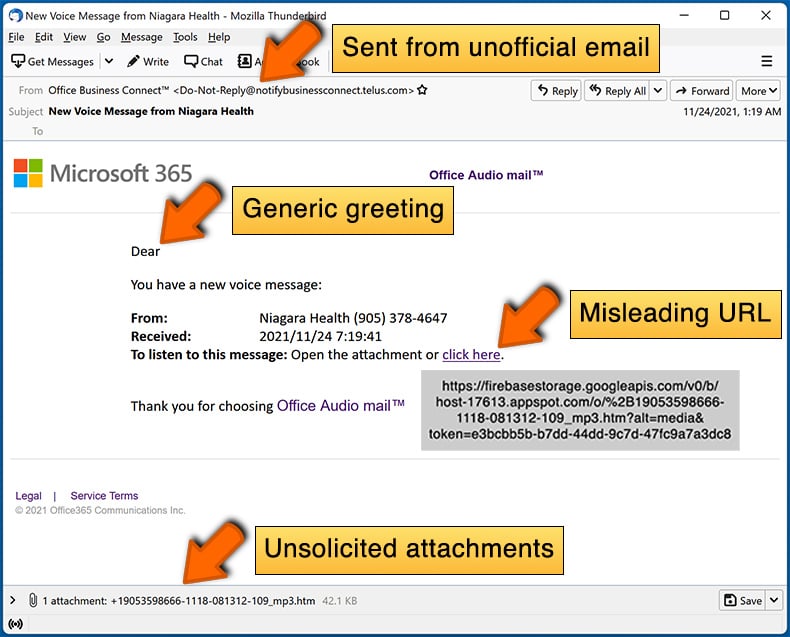How to identify scams like "Binance Charity - California Wildfires Fundraiser"
Phishing/ScamAlso Known As: Fake Binance Charity - California Wildfires Fundraiser
Get free scan and check if your device is infected.
Remove it nowTo use full-featured product, you have to purchase a license for Combo Cleaner. Seven days free trial available. Combo Cleaner is owned and operated by RCS LT, the parent company of PCRisk.com.
What is "Binance Charity - California Wildfires Fundraiser" scam?
After reviewing the email, we have determined that it is a scam disguised as an invitation to join a fundraiser. The scam aims to deceive individuals into sending cryptocurrency under the false premise of contributing to a fundraising campaign. It is highly advisable to ignore such emails to avoid monetary loss and other issues.

More about the "Binance Charity - California Wildfires Fundraiser" scam email
This scam email pretends to be a fundraising campaign for the victims of the California wildfires. It claims to collect cryptocurrency donations to provide immediate relief and long-term support for those affected. The email states how different donation amounts will supposedly help the victims, such as providing meals or rebuilding homes.
It also claims that the campaign has already raised millions. The email included multiple cryptocurrency wallet addresses and asks recipients to send their donations. Moreover, it says that donations will be tracked and transparent. Overall, the scammers behind this email aim to trick people into sending cryptocurrency, which they will steal.
It is important to mention that recovering cryptocurrency lost in a scam can be extremely difficult and, in most cases, practically impossible. Thus, emails like this one should be carefully examined before making any transactions or taking other actions to avoid monetary loss.
| Name | Binance Charity - California Wildfires Fundraiser Email Scam |
| Threat Type | Phishing, Scam, Social Engineering, Fraud |
| Fake Claim | Binance has launched fundraiser for victims of California wildfires |
| Cyber Criminal Cryptowallet Addressess | bc1qf5v946vwt5hczzuxpaks9ry778xgcr9kxv6m4u, TBGgZPFxH4k3ied8iNaVhidNofFzNp5Bk2, ltc1q3aja7f2f0kv8kxgkrjzp8zaw2ug6l8jcv3mvzs, 0xB9C7D11d77ff13cf13B413f7e6cd1f80Aa10dF47 |
| Disguise | Letter from Binance charity |
| Symptoms | Generic greeting, urgent language, suspicious links, grammatical errors. |
| Distribution methods | Deceptive emails, rogue online pop-up ads, search engine poisoning techniques, misspelled domains. |
| Damage | Monetary loss. |
| Malware Removal (Windows) |
To eliminate possible malware infections, scan your computer with legitimate antivirus software. Our security researchers recommend using Combo Cleaner. Download Combo CleanerTo use full-featured product, you have to purchase a license for Combo Cleaner. 7 days free trial available. Combo Cleaner is owned and operated by RCS LT, the parent company of PCRisk.com. |
Similar scam emails in general
Scams like this often aim to lure users into transferring money to scammers by masquerading as legitimate charitable campaigns. It is important to be cautious and verify the authenticity of such requests before sending any funds, as recovery is often impossible once the money is lost.
Some examples of other scam emails are "Funds Disbursed By Presidential Administration", "PROTON LOTTERY", and "Bittrex Inc Bankruptcy Notice". Apart from trying to steal money or information, fraudsters can use email to deliver malware.
How do spam campaigns infect computers?
Threat actors distribute malware through email by attaching harmful files or links. When a user opens these files (or takes additional actions, for instance, enabling macros in a malicious MS Office document), the malware can infect their computer. The files may include PDFs, executables, script files, compressed files like ZIPs, etc.
Sometimes, these deceptive emails can take users to untrustworthy or compromised websites where the malware downloads automatically, or they may trick users into launching (executing) the malware on their own.
How to avoid installation of malware?
Do not open links and files in suspicious emails (e.g., irrelevant emails from unknown addresses). Download programs and files from official websites or app stores. Avoid interacting with questionable ads, pop-ups, or other content on shady sites, and do not allow those pages to send you notifications.
Keep your operating system and software up to date, and run regular scans with a trusted security tool. If you have already opened malicious attachments, we recommend running a scan with Combo Cleaner Antivirus for Windows to automatically eliminate infiltrated malware.
The appearance of the scam email (GIF):

Text presented in the "Binance Charity - California Wildfires Fundraiser" email letter:
Subject: Be a Part of the California Wildfire Relief Effort ********
Dear ********,The recent California wildfires have resulted in widespread displacement, leaving thousands without homes, food, or basic necessities. As a result, we have initiated an urgent cryptocurrency fundraising campaign to offer immediate relief and long-term assistance to those impacted.
The Benefits of Your Contribution
Your contributions can make a real impact. Here’s what various donation amounts can accomplish:
$50 – Provides meals for a displaced family for a week.
$500 – Helps rebuild part of a damaged home.
$5,000 – Funds a community relief shelter for evacuees.Our Fundraising Objective & Progress Overview
We aim to gather $85,000,000, and thanks to your support, we have already reached $24,993,888. Every contribution brings us closer to ensuring that wildfire victims receive the support they need.How to Assist
To give, please transfer your contribution to the wallet address of your desired cryptocurrency:Bitcoin (BTC)
bc1qf5v946vwt5hczzuxpaks9ry778xgcr9kxv6m4uEthereum (ETH)
0xB9C7D11d77ff13cf13B413f7e6cd1f80Aa10dF47Binance Smart Chain (BNB) BEP20
0xB9C7D11d77ff13cf13B413f7e6cd1f80Aa10dF47TRON (TRX)
TBGgZPFxH4k3ied8iNaVhidNofFzNp5Bk2Litecoin (LTC)
ltc1q3aja7f2f0kv8kxgkrjzp8zaw2ug6l8jcv3mvzsTether (USDT) - Multiple Networks
ERC20 (Ethereum): 0xB9C7D11d77ff13cf13B413f7e6cd1f80Aa10dF47
TRC20 (Tron): TBGgZPFxH4k3ied8iNaVhidNofFzNp5Bk2
BEP20 (Binance Smart Chain - BSC): 0xB9C7D11d77ff13cf13B413f7e6cd1f80Aa10dF47USD Coin (USDC) - Multiple Networks
ERC20 (Ethereum): 0xB9C7D11d77ff13cf13B413f7e6cd1f80Aa10dF47
TRC20 (Tron): TBGgZPFxH4k3ied8iNaVhidNofFzNp5Bk2
BEP20 (Binance Smart Chain - BSC): 0xB9C7D11d77ff13cf13B413f7e6cd1f80Aa10dF47For Other Cryptos: If you prefer to donate with an alternative cryptocurrency, please let us know, and we will supply the right wallet address.
Employing cryptocurrency allows for faster transactions, lower costs, and improved transparency, ensuring your donation arrives to those in need without delays.Transparency & Impact Updates
We pledge to maintain total transparency in fund usage. Every donation will be tracked, and we will share regular updates on the impact of your contributions.
Your assistance can truly change the lives of wildfire survivors. If you have questions or need support with the donation process, feel free to get in touch.
We appreciate your assistance ahead of time.Thank you
Binance Charity in association with
Instant automatic malware removal:
Manual threat removal might be a lengthy and complicated process that requires advanced IT skills. Combo Cleaner is a professional automatic malware removal tool that is recommended to get rid of malware. Download it by clicking the button below:
DOWNLOAD Combo CleanerBy downloading any software listed on this website you agree to our Privacy Policy and Terms of Use. To use full-featured product, you have to purchase a license for Combo Cleaner. 7 days free trial available. Combo Cleaner is owned and operated by RCS LT, the parent company of PCRisk.com.
Quick menu:
- What is Fake Binance Charity - California Wildfires Fundraiser?
- Types of malicious emails.
- How to spot a malicious email?
- What to do if you fell for an email scam?
Types of malicious emails:
![]() Phishing Emails
Phishing Emails
Most commonly, cybercriminals use deceptive emails to trick Internet users into giving away their sensitive private information, for example, login information for various online services, email accounts, or online banking information.
Such attacks are called phishing. In a phishing attack, cybercriminals usually send an email message with some popular service logo (for example, Microsoft, DHL, Amazon, Netflix), create urgency (wrong shipping address, expired password, etc.), and place a link which they hope their potential victims will click on.
After clicking the link presented in such email message, victims are redirected to a fake website that looks identical or extremely similar to the original one. Victims are then asked to enter their password, credit card details, or some other information that gets stolen by cybercriminals.
![]() Emails with Malicious Attachments
Emails with Malicious Attachments
Another popular attack vector is email spam with malicious attachments that infect users' computers with malware. Malicious attachments usually carry trojans that are capable of stealing passwords, banking information, and other sensitive information.
In such attacks, cybercriminals' main goal is to trick their potential victims into opening an infected email attachment. To achieve this goal, email messages usually talk about recently received invoices, faxes, or voice messages.
If a potential victim falls for the lure and opens the attachment, their computers get infected, and cybercriminals can collect a lot of sensitive information.
While it's a more complicated method to steal personal information (spam filters and antivirus programs usually detect such attempts), if successful, cybercriminals can get a much wider array of data and can collect information for a long period of time.
![]() Sextortion Emails
Sextortion Emails
This is a type of phishing. In this case, users receive an email claiming that a cybercriminal could access the webcam of the potential victim and has a video recording of one's masturbation.
To get rid of the video, victims are asked to pay a ransom (usually using Bitcoin or another cryptocurrency). Nevertheless, all of these claims are false - users who receive such emails should ignore and delete them.
How to spot a malicious email?
While cyber criminals try to make their lure emails look trustworthy, here are some things that you should look for when trying to spot a phishing email:
- Check the sender's ("from") email address: Hover your mouse over the "from" address and check if it's legitimate. For example, if you received an email from Microsoft, be sure to check if the email address is @microsoft.com and not something suspicious like @m1crosoft.com, @microsfot.com, @account-security-noreply.com, etc.
- Check for generic greetings: If the greeting in the email is "Dear user", "Dear @youremail.com", "Dear valued customer", this should raise suspiciousness. Most commonly, companies call you by your name. Lack of this information could signal a phishing attempt.
- Check the links in the email: Hover your mouse over the link presented in the email, if the link that appears seems suspicious, don't click it. For example, if you received an email from Microsoft and the link in the email shows that it will go to firebasestorage.googleapis.com/v0... you shouldn't trust it. It's best not to click any links in the emails but to visit the company website that sent you the email in the first place.
- Don't blindly trust email attachments: Most commonly, legitimate companies will ask you to log in to their website and to view any documents there; if you received an email with an attachment, it's a good idea to scan it with an antivirus application. Infected email attachments are a common attack vector used by cybercriminals.
To minimise the risk of opening phishing and malicious emails we recommend using Combo Cleaner Antivirus for Windows.
Example of a spam email:

What to do if you fell for an email scam?
- If you clicked on a link in a phishing email and entered your password - be sure to change your password as soon as possible. Usually, cybercriminals collect stolen credentials and then sell them to other groups that use them for malicious purposes. If you change your password in a timely manner, there's a chance that criminals won't have enough time to do any damage.
- If you entered your credit card information - contact your bank as soon as possible and explain the situation. There's a good chance that you will need to cancel your compromised credit card and get a new one.
- If you see any signs of identity theft - you should immediately contact the Federal Trade Commission. This institution will collect information about your situation and create a personal recovery plan.
- If you opened a malicious attachment - your computer is probably infected, you should scan it with a reputable antivirus application. For this purpose, we recommend using Combo Cleaner Antivirus for Windows.
- Help other Internet users - report phishing emails to Anti-Phishing Working Group, FBI’s Internet Crime Complaint Center, National Fraud Information Center and U.S. Department of Justice.
Frequently Asked Questions (FAQ)
Why did I receive this email?
Scammers often send these emails to a wide audience without tailoring them to individuals. They typically gather email addresses from data leaks, scam websites, or using other methods.
I have provided my personal information when tricked by this email, what should I do?
Contact the relevant authorities as soon as possible. If you have disclosed details like login credentials, contact the service provider.
I have downloaded and opened a malicious file attached an email, is my computer infected?
The risk of infection depends on the file type. Executable files are more dangerous, while documents are less risky. However, malicious MS Office documents can still be harmful if macros are enabled.
I have sent cryptocurrency to the address presented in such email, can I get my money back?
Recovering cryptocurrency lost to a scam is very challenging and, in most cases, nearly impossible.
I have read the email but did not open the attachment, is my computer infected?
It is safe to open emails without interacting with attached files or included links.
Will Combo Cleaner remove malware infections that were present in email attachment?
Combo Cleaner can identify and remove most known malware, but more advanced threats may stay hidden deep in your system. To ensure complete removal, it is best to run a full system scan.
Share:

Tomas Meskauskas
Expert security researcher, professional malware analyst
I am passionate about computer security and technology. I have an experience of over 10 years working in various companies related to computer technical issue solving and Internet security. I have been working as an author and editor for pcrisk.com since 2010. Follow me on Twitter and LinkedIn to stay informed about the latest online security threats.
PCrisk security portal is brought by a company RCS LT.
Joined forces of security researchers help educate computer users about the latest online security threats. More information about the company RCS LT.
Our malware removal guides are free. However, if you want to support us you can send us a donation.
DonatePCrisk security portal is brought by a company RCS LT.
Joined forces of security researchers help educate computer users about the latest online security threats. More information about the company RCS LT.
Our malware removal guides are free. However, if you want to support us you can send us a donation.
Donate
▼ Show Discussion